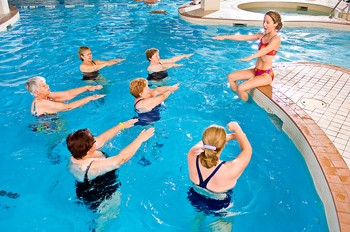Stay Fit In Water – Water Aerobics
Water Aerobics is a great solution to your fitness problems. You don’t even need to know how to swim Water aerobics and Water exercise have been a poplar way of keeping fit for years, particularly for people with certain health problems or those recuperating from injury and types of resistance training. The use of water supports the body and reduces the risk of muscle or joint injury. The mitigation of gravity by flotation places less stress on the joints when stretching, and can allow a greater range of motion.
Range of Water Aerobic Workouts
There is also a growing trend of pools and gyms offering an increasing range of workouts like Water Boxing and Aquatic Step. As a result, it appeals to a wider range of people than ever and, regardless of your fitness level, there’s a good chance you’ll find a water exercise class that you’ll enjoy.
It may be performed with or without pool equipment such as hand and feet flippers, different foam floats such as “noodles” and weights. They may also be held in diverse water depths, with some deep water classes providing float belts to assists exercises. Generally you don’t even need to be able to swim.
It is broken down into two main groups; Aqua aerobics and aquatic exercises. The first is more low-impact than land-based aerobics but has most of the fat-burning and endurance-building benefits that you get from other forms of aerobic activity. An aerobic water exercise of around 30 minutes will help you burn about 300 calories. It helps in weight loss, builds vigor and flexibility and is an excellent cardio-respiratory exercise.
Water aerobics feature vertical exercises that often mimic land exercises, like dancing, walking, running, jumping jacks, and kickboxing. While swimming is a horizontal exercise, vertical exercise increase the workload because they’re done below the surface where drag is greater.
Water Aerobics – Benefits
- High calorie burning during and after a workout.
- Renews your energy level as it releases your stress and tension.
- Allows a greater range of motion and also prevents overheating. It improves cardiovascular fitness.
- Allows you to exercise every muscle and joint at same time.
- Guarantees privacy.
- Easier to perform since in water you need to support only 50 percent of your body weight.
- No need for any special equipment.
- Lowers the risks of stress related injuries.
- Eliminates panic of any mishap.
- Reduces pain perception and provides relief.
- Targets specific body areas to exercise or combine several movements in to a complete heat-to-toe activity.
Water Aerobics – Start walking
If you’re just beginning, start slowly by waling in shallow water. Steadily increase the intensity of your calisthenics by moving to waist-high, then chest-high water, and adding movements that use both arms and legs. Always do a five-minute warm-up and cool-down.
In addition one can isolate certain moves and reinforce them in the water. For example, a golfer, tennis player or baseball player can stand in chest-deep water and practice their swings, paying close attention to proper technique. Resistance devices, such as paddles, can be used to make the workout more challenging. For variety, do an aquatic circuit-training workout that incorporates exercises such as boxing punches, soccer kicks, and cross-country skiing movements.
Water Exercise – Aquastic Aerobics
Take your favorite yoga, Pilates, and tai chi exercises to the water to learn the popular mind and body movements. For example, the yoga “warrior” position performed in waist-high water provides relaxation, relieves stiffness in the waist and rib areas, stretches the entire body, and strengthens shoulder, arms and legs.
In aquatic exercise, resistance and strengthening exercises aim to improving tone, strength and mobility. Compared to land exercises where you work only against gravity, this offers resistance in all directions because of water’s cushioning effect. This form of exercise is particularly beneficial to anyone at risk from bodily stress, including the elderly, obesity (overweight), or those recovering from soft tissue injury. It’s also particularly good for pregnant women and is an ideal post-natal exercise. Its benefits include increased aerobic endurance greater flexibility and increased muscle tone. Deep water exercises offers a no-impact workout and has long been allied with rehabilitation. Using flotation belts, you can jog, run, do sit- ups, and more.
Water Aerobics – Relief for joints
For about 25 years, water exercise has been prescribed for people with arthritis. It has an array of motion and flexibility and relieves joints pain and stiffness, other health conditions including asthma, obesity, pregnancy, back problems and more. But consult your doctor before beginning. A simple way of incorporating water exercise into your regular exercise regime is simply waling, jogging or running in water. Start by waling through the shallow end of a pool, increasing the depth to waist or chest level as your fitness increases. This exercise is great for toning legs and strengthening your hips as well as increasing cardio-respiratory fitness levels.
Water squats are great for toning your lower body as well: Bend your knees and squat as low as you can comfortably manage, using the side of the pool to steady your balance if necessary (but don’t use it to support your weight or you’ll lose the effect of the exercise). Return to standing. Repeat 5-10 times.
If you suffer from arthritis or joint problems, back pain, neck pain, soft-tissue injury or cardiac problems, consult your doctor before beginning. Water aerobics is the perfect answer to your fitness needs or goals because it is adoptable to all personal conditions, illness, injuries and post surgeries.

